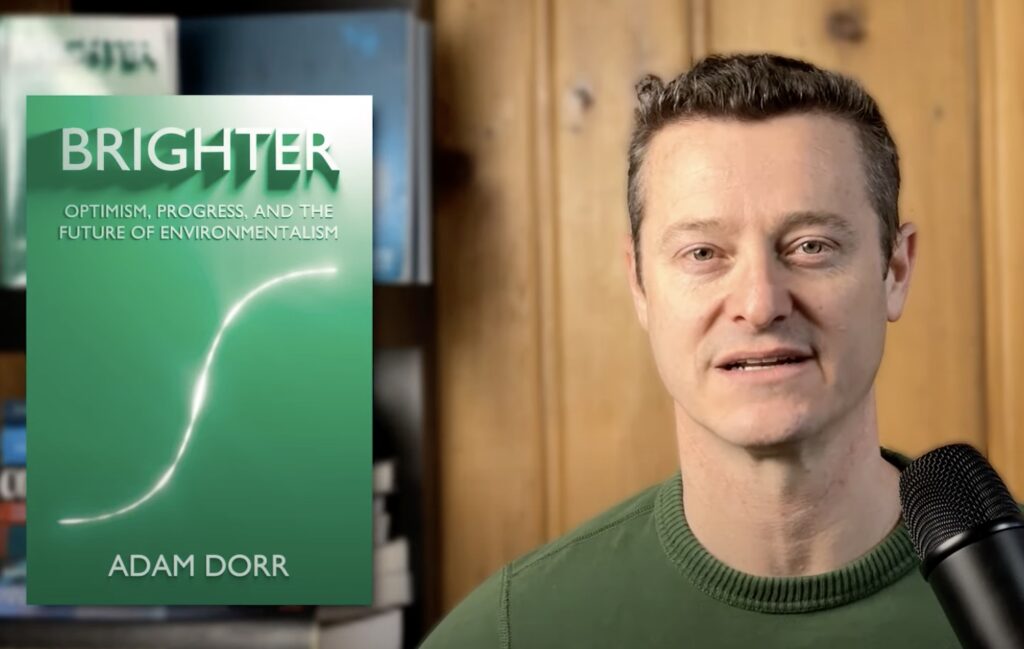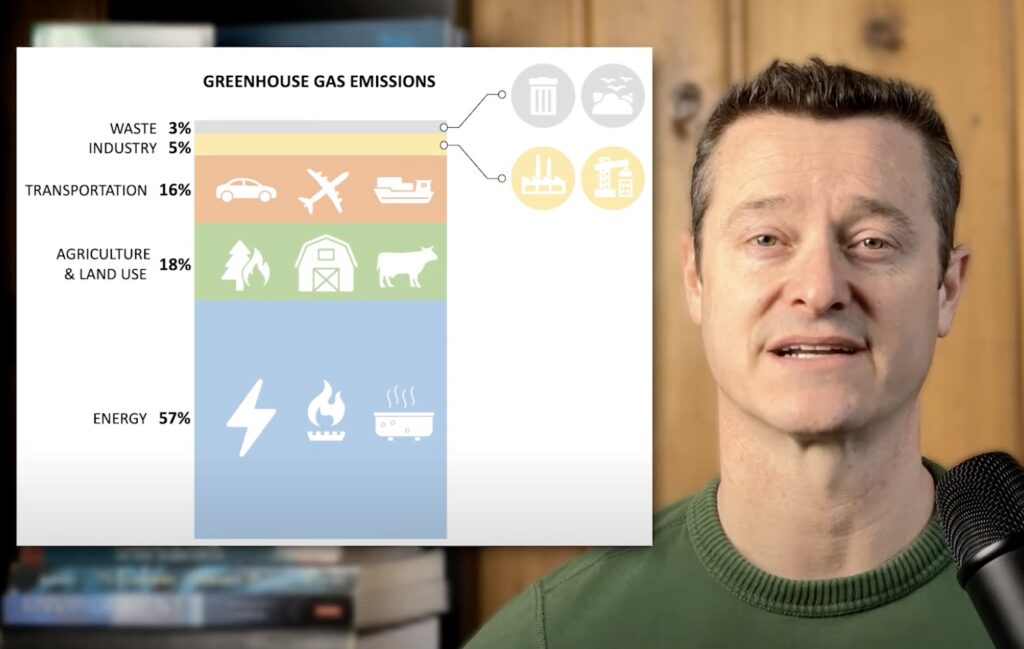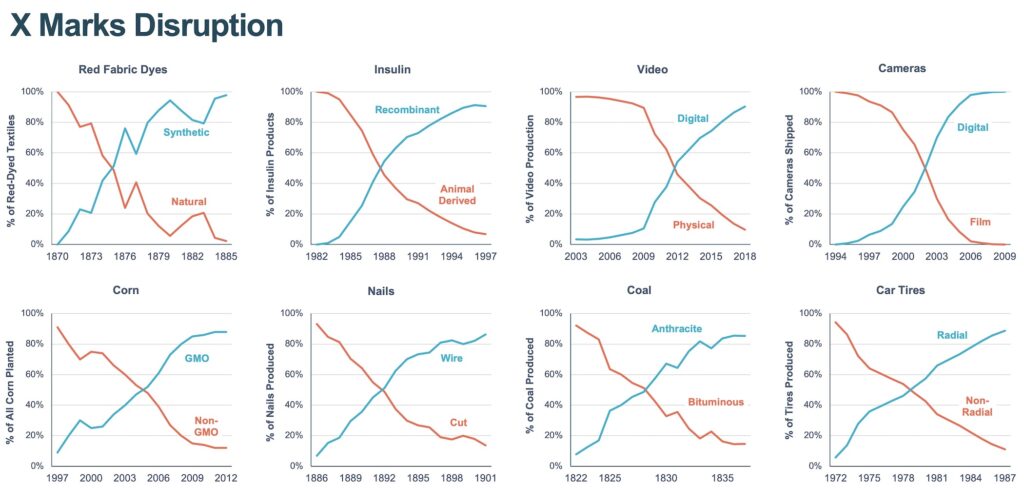This is a transcript of ‘Episode 1 – The future of the environment is brighter than you think’ by Adam Dorr. The entire series is available on YouTube. The book on which the series is based, “Brighter: Optimism, Progress, and the Future of Environmentalism” is available on Amazon.

Hi everyone, Adam Dorr from RethinkX here. Thanks for joining me. This is going to be the first video in a series that covers some of the ideas in my new book, as well as a wide range of topics that our research team at RethinkX is exploring.
In this video, we’ll introduce the general thesis of the book, whose full title is “Brighter: Optimism, Progress, and the Future of Environmentalism”. We’ll look at the core logic and the evidence behind it.
So, let’s dive right in. The book’s thesis is that there has never been greater cause for optimism about the future of the environment because we are on the cusp of technology disruptions in four foundational sectors: Energy, Transportation, Food, and Labor. The new clean technologies that are driving these disruptions will enable us to solve many of our most pressing environmental problems, including climate change.
That’s it. That’s the thesis in a nutshell.
Why We Have Had Such Serious Environmental Problems
Okay, so let’s dig in a little deeper. To start off: Why? We have we had such serious environmental problems up until now? Well, it’s because we’ve been stuck with dirty, expensive older technology – fossil fuels, combustion engine vehicles, animal agriculture. There’s a great deal of pessimism around environmental issues because most folks are under the false impression that we will continue to be stuck with these old technologies for decades or centuries to come.
Why be optimistic? Well, it’s because we aren’t stuck. The clean technologies we need to solve our environmental problems already exist; they’re here today. In energy, the technologies are solar power, wind power, batteries, and heat pumps. In transportation, it’s electric vehicles, autonomous driving, and ride-hailing. In food, it’s precision fermentation and cellular agriculture. In labor, it’s artificial intelligence, automation, and robotics.

These aren’t science fiction anymore. Thirty years ago, they still were, but today they’re science fact. They’re here and they’re getting cheaper by the minute.
What is Disruption and Why are These Ones So Good?
What do we mean by ‘disruption’? A disruption occurs when new technology emerges that dramatically outperforms – and therefore out-competes older technology – that rapidly transforms a market, a segment, an industry, an entire sector of the economy as a result.
Four disruptions: Energy, Transportation, Food, and Labor. Any one of them would be world-changing on its own, just as the disruption of information and communications by the internet has been world-changing.
But all four of them simultaneously? That’s nothing short of astonishing.
Now, luckily, these disruptions are being driven by clean technologies. That did not have to be the case. We have had dirty disruptions in the past. Fossil fuels themselves disrupted biofuels in the 19th century, for example.
So why are these four disruptions today such amazingly good news for the environment? There are three key reasons.
First, they will directly mitigate greenhouse gas emissions. Ninety percent of all emissions today come from energy, transportation, and food. So disrupting those sectors with clean technologies gets us most of the way to net zero emissions.

Second, disruptions happen for economic reasons. The new technology is better and cheaper, and so it outcompetes the older technology. And “better” can mean a lot of different things. It can mean more efficient, cleaner, higher quality, and so on. But the bottom line is that the new technology offers much greater value for money.
We’re talking about Energy, Transportation, Food, and Labor here. Those things are cornerstones of the global economy, of civilization itself. They are foundational because they’re inputs into everything else. What does that mean? It means that as these four things become cheaper, everything we make with them, everything we do with them, will become cheaper too.
So, the four disruptions are going to make everything much, much cheaper.
And that’s fantastic news in general, but it’s especially crucial for the environment. Why? Because the main reason why solving environmental problems today is difficult is because it’s so expensive. It’s not that we don’t know how to solve water pollution, deforestation, or soil contamination, or any of those other challenges we face. It’s that solving these problems is costly.
That means they only get solved today in places where there’s plenty of economic prosperity. Well, the disruption of Energy, Transportation, Food, and Labor is going to create an explosion of economic prosperity worldwide. So solving environmental challenges will finally be affordable everywhere, not just in the wealthiest communities and countries.
Disruptions Happen Fast
And third, disruptions happen fast. They don’t take 50 or 100 years. They only take around fifteen years. We’ve seen this again and again for technologies of all kinds throughout history, from arrowheads to insulin, from carpenter’s nails to car tires, from fabric dyes to digital cameras. When a cheaper, better technology comes along, the change naturally happens quickly.

We used horses for transportation for thousands of years, but in most locations, the disruption by cars only took fifteen years. Kodak was the titan of photography for over a century, but it was bankrupt within a decade after the first affordable digital camera became available.
So, even the most powerful incumbents are vulnerable. The fossil fuel industry is no exception. It doesn’t matter how dominant your share of a market is if that market itself collapses because demand shifts to a new alternative instead.
It didn’t matter that coal was a giant industry in a foundational sector of the U.S. economy for 150 years. It didn’t matter that it was worth tens of billions of dollars and had plenty of political clout. Americans turned away from coal starting in around 2011 to natural gas and renewables, and a decade later, the U.S. coal industry had all but collapsed. That’s disruption.

Environmental Problems
Now, let me reiterate, the environmental problems we face are very real. They are extremely serious. There’s no contesting that. Climate change, ocean acidification, biodiversity loss, species extinction, overfishing and coral bleaching, deforestation and desertification, habitat fragmentation and destruction, air and water pollution, soil contamination and erosion, factory farming, animal rights — all of these issues and more threaten ecological integrity and human well-being. We can’t ignore any of them.
But the reason why so many of us are so pessimistic is that up until now, it hasn’t been clear exactly how we can solve these problems. The situation has seemed hopeless. That’s what I’m trying to change.
My goal is to help people — the public, policymakers, civic leaders, investors, activists, my fellow scientists — all understand exactly how the disruption of energy, transportation, food, and labor by new technologies will give us the tools we need to meet our environmental challenges.
So, this is not about mustering an optimistic attitude. There’s no magical or wishful thinking involved anywhere here. It’s about having reasons for being optimistic. In fact, having a clear view of our technological future is absolutely critical to making sound environmental policy, planning, advocacy, and investment decisions going forward.
Above all, I hope others will come to share my optimism as we go through the evidence around these four disruptions. Our future is far, far brighter than most of us have dared to imagine up until now.
I’ll wrap up there for today. In future videos, we’ll get into the details of exactly how we can meet our environmental challenges with these new technologies, and how it’s going to transform our relationship with the natural world.
There are links to the book and RethinkX’s other publications in the description below. If you’re new to the channel, please consider subscribing and giving us a thumbs up. That really does help increase our visibility and it magnifies the impact of our work.
Thanks everyone for watching and as always, thank you so much to my team at RethinkX for all of your support and for your amazing work. We’ll see you next time, and just remember, the future is brighter than you think. Take care.

Hi Adam and RethinkX.
For energy and transportation, most can more or less see that the transition has begone. Food however with it’s huge implications for traditional agriculture is much harder to see or believe. I’d love to see a video by you/ RethinkX about the food disruption. What is the actual state of things in 2023? Are those products real? How do companies on the market? Where are we on the “S- curve”? Last thing I heard about animal- free meat companies was not that great. Thanks for your work.
I agree with the previous poster that food is much harder to see (renewable energy for energy and transportation is obviously going to cause a phase change).
Precision fermentation to make food is aerobic and is _completely_ different from anaerobic fermentation. It requires a massive amount of oxygen and oxygen is poorly soluble in water. This is why single cell protein has failed over and over again – it’s never cheaper than soy protein.
Foam fermentation for single cell protein has potential to solve this oxygen problem, especially since the energy transition will free up carbohydrates that were being used for bioethanol and methane that was being used to make electricity.
cellofuel.com